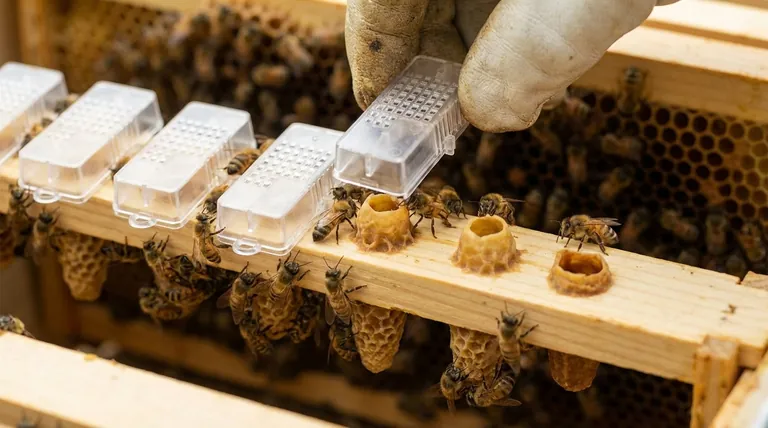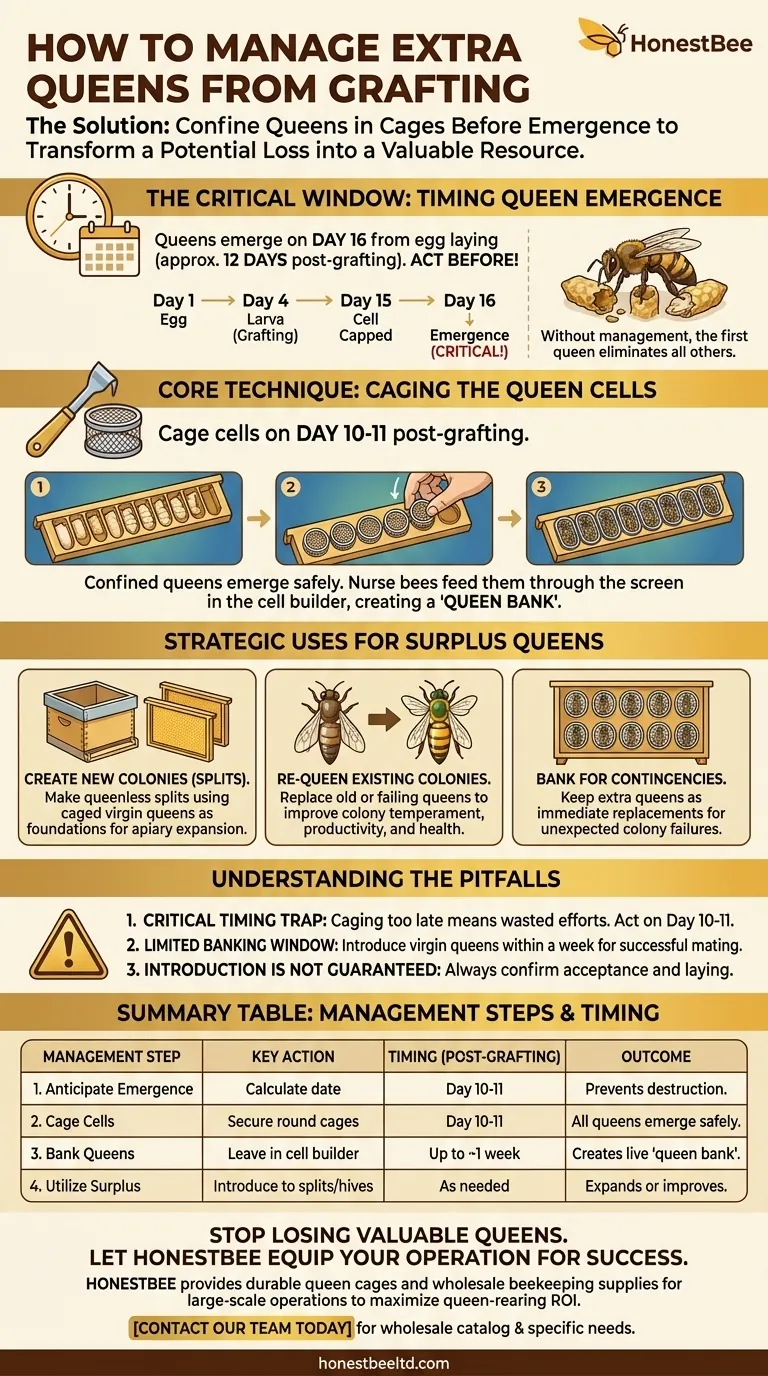The most effective way to manage extra queens is to confine them within cages directly on the cell bar just before they emerge. This simple, proactive step prevents the first emerged queen from destroying the others, transforming your surplus queens from a potential loss into a valuable resource for your apiary.
The core challenge isn't the existence of extra queens, but the timing of their emergence. By anticipating and managing this event with queen cages, you gain complete control, allowing you to "bank" these queens or use them strategically to strengthen your operation.

The Critical Window: Timing Queen Emergence
The entire management process hinges on acting before the first virgin queen emerges. Once the first queen is free, she will methodically seek out and destroy all other queen cells, eliminating your surplus.
Calculating the Emergence Date
Queens emerge on day 16, counting from the day the egg was laid. Since grafting is typically done with 1-day-old larvae (which are 4 days old from the egg stage), you can expect emergence around 12 days after you graft. Mark your calendar precisely.
The Inevitable Outcome of Inaction
If left unmanaged, the first virgin queen to emerge will kill her rivals while they are still helpless within their cells. All your work raising multiple queens will be lost in a matter of hours, leaving you with only one.
Core Technique: Caging the Queen Cells
Caging is the essential technique that gives you control over the situation. It allows all queens to emerge safely without being able to harm one another.
Using Round Queen Cages
The most common method involves using round queen cages or roller cages. Approximately 10-11 days after grafting, you must visit the cell builder and gently press one of these cages over each individual queen cell, securing it to the wax of the cell bar.
Confining Queens in the Cell Builder
Once the queens emerge, they will be safely confined within their individual cages. They can remain in the high-population cell builder colony for several days. The resident nurse bees will feed and care for the caged queens through the screen, creating a "queen bank."
Strategic Uses for Surplus Queens
With your queens safely caged and banked, you now have several powerful options for improving your apiary.
Creating New Colonies (Splits)
Each extra queen is the foundation of a new colony. You can make a queenless split (a nuc or nucleus colony) by taking frames of brood, pollen, and honey from a strong hive and introducing one of your caged virgin queens. The cage serves as a perfect introduction cage.
Re-queening Existing Colonies
Use your surplus queens to replace old, failing, or undesirable queens in your established hives. A young, well-bred queen can dramatically improve a colony's temperament, productivity, and health.
Banking for Contingencies
Keeping a few extra queens "on the books" in your queen bank is excellent insurance. If a colony unexpectedly goes queenless, you have an immediate replacement ready without having to wait weeks for the bees to raise a new one.
Understanding the Pitfalls
While this process is highly effective, success depends on avoiding a few common mistakes.
The Critical Timing Trap
The single biggest failure point is timing. If you cage the cells too late and a queen has already emerged, your efforts are wasted. Be conservative and cage the cells on day 10 or 11 post-grafting to be safe.
Limited Banking Window
While you can bank newly emerged virgin queens, it's not a long-term solution. They must be introduced to a colony or nuc within a reasonable timeframe so they can embark on their essential mating flights. Banking for more than a week can be detrimental.
Introduction is Not Guaranteed
Using the cage as an introduction tool greatly increases the odds of acceptance, but it is never 100% certain. Always confirm the new queen has been accepted and is laying eggs a week or so after you release her.
Making the Right Choice for Your Goal
Your approach to using extra queens should align directly with your beekeeping objectives.
- If your primary focus is apiary expansion: Prioritize using every viable queen to make a queenless split, as this is the fastest way to increase your colony count.
- If your primary focus is genetic improvement: Use your surplus queens to systematically re-queen any colonies with poor performance or undesirable traits.
- If your primary focus is risk management: Always aim to bank a few extra queens as immediate replacements for any unforeseen colony failures during the season.
Proactive management transforms surplus queens from a potential liability into one of your apiary's most valuable assets.
Summary Table:
| Management Step | Key Action | Timing (Post-Grafting) | Outcome |
|---|---|---|---|
| 1. Anticipate Emergence | Calculate emergence date | Day 10-11 | Prevents first queen from destroying others |
| 2. Cage Cells | Secure round cage over each cell | Day 10-11 | All queens emerge safely, confined |
| 3. Bank Queens | Leave caged queens in cell builder | Up to ~1 week | Creates a live 'queen bank' for immediate use |
| 4. Utilize Surplus | Introduce to splits or re-queen hives | As needed | Expands apiary or improves genetics |
Stop Losing Valuable Queens. Let HONESTBEE Equip Your Operation for Success.
Managing queen emergence requires precision and the right equipment. As a trusted wholesale supplier for commercial apiaries and distributors, HONESTBEE provides the durable, reliable queen cages and beekeeping supplies you need to execute this technique flawlessly and maximize your queen-rearing ROI.
We help large-scale beekeepers like you turn potential losses into profitable assets. Contact our team today to discuss your specific needs and explore our wholesale catalog.
Visual Guide

Related Products
- Professional Multi-Functional Queen Bee Cage
- Wood and Mesh Push-In Queen Cage
- Classic Wooden and Mesh California Queen Cage
- Professional Round Push-In Queen Cage with Metal Tines
- Multi-Function Queen Roller Cage and Catcher
People Also Ask
- What should be done if bees damage the queen cage or harm the queen? Rescue Your Queen and Save Your Hive
- What are the components of a standard queen cage? A Guide to Safe Queen Introduction
- What are common mistakes to avoid when using queen cages? Ensure Successful Queen Introduction
- How should a queen cage be maintained over time? Ensure Queen Introduction Success
- How long does it typically take bees to adjust to a new queen? Master the 2-7 Day Acceptance Window



















